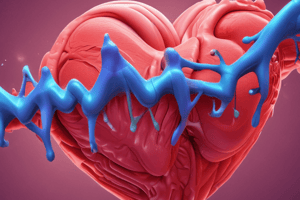Podcast
Questions and Answers
Digoxin exerts its positive inotropic effect by which mechanism?
Digoxin exerts its positive inotropic effect by which mechanism?
- Enhancing potassium efflux from cardiac cells
- Increasing intracellular calcium concentration (correct)
- Inhibiting beta-adrenergic receptors
- Stimulating the sodium-potassium ATPase pump
Which of the following electrolyte imbalances would increase a patient's susceptibility to digoxin toxicity?
Which of the following electrolyte imbalances would increase a patient's susceptibility to digoxin toxicity?
- Hypocalcemia
- Hypokalemia (correct)
- Hyperkalemia
- Hypermagnesemia
A patient with atrial fibrillation is prescribed digoxin. What is the primary therapeutic goal of digoxin in this scenario?
A patient with atrial fibrillation is prescribed digoxin. What is the primary therapeutic goal of digoxin in this scenario?
- To convert the patient to normal sinus rhythm
- To decrease the ventricular response rate (correct)
- To prevent the formation of atrial thrombi
- To increase the force of atrial contraction
Which of the following is a common neurological side effect associated with digoxin toxicity?
Which of the following is a common neurological side effect associated with digoxin toxicity?
A patient with a history of heart failure and renal impairment is started on digoxin. Which adjustment to the typical dosing regimen is most appropriate?
A patient with a history of heart failure and renal impairment is started on digoxin. Which adjustment to the typical dosing regimen is most appropriate?
Which medication, when co-administered with digoxin, is most likely to cause a significant increase in serum digoxin levels?
Which medication, when co-administered with digoxin, is most likely to cause a significant increase in serum digoxin levels?
What is the primary route of elimination for digoxin from the body?
What is the primary route of elimination for digoxin from the body?
In a patient exhibiting signs of severe digoxin toxicity, which intervention is most appropriate?
In a patient exhibiting signs of severe digoxin toxicity, which intervention is most appropriate?
Which of the following conditions is a contraindication for the use of digoxin?
Which of the following conditions is a contraindication for the use of digoxin?
What is the typical therapeutic range for serum digoxin levels (in ng/mL)?
What is the typical therapeutic range for serum digoxin levels (in ng/mL)?
A patient on digoxin develops nausea, vomiting, and loss of appetite. Which of the following actions is most appropriate?
A patient on digoxin develops nausea, vomiting, and loss of appetite. Which of the following actions is most appropriate?
Which of the following best describes how digoxin affects the AV node?
Which of the following best describes how digoxin affects the AV node?
A patient is prescribed digoxin and a loop diuretic. What electrolyte level should be closely monitored due to the increased risk of digoxin toxicity?
A patient is prescribed digoxin and a loop diuretic. What electrolyte level should be closely monitored due to the increased risk of digoxin toxicity?
What is the significance of digoxin's relatively large volume of distribution?
What is the significance of digoxin's relatively large volume of distribution?
Which of the following factors necessitates careful consideration when prescribing digoxin to geriatric patients?
Which of the following factors necessitates careful consideration when prescribing digoxin to geriatric patients?
A patient with hypothyroidism may require what adjustment to their digoxin dosage?
A patient with hypothyroidism may require what adjustment to their digoxin dosage?
Which of the following best describes the mechanism by which antacids can interact with digoxin?
Which of the following best describes the mechanism by which antacids can interact with digoxin?
What is the approximate half-life of digoxin in a patient with normal renal function?
What is the approximate half-life of digoxin in a patient with normal renal function?
In pediatric patients, digoxin dosing is primarily based on what factors?
In pediatric patients, digoxin dosing is primarily based on what factors?
Which of the following ECG findings would be most concerning in a patient taking digoxin?
Which of the following ECG findings would be most concerning in a patient taking digoxin?
Flashcards
What is Digoxin?
What is Digoxin?
A cardiac glycoside medication used to manage heart failure and irregular heartbeats.
Digoxin's mechanism of action?
Digoxin's mechanism of action?
Inhibits the sodium-potassium ATPase pump in cardiac myocytes, increasing intracellular sodium and calcium, enhancing myocardial contraction, and slowing AV node conduction.
Indications for Digoxin?
Indications for Digoxin?
Symptoms improve in heart failure and it controls ventricular rate in atrial fibrillation/flutter.
Digoxin elimination?
Digoxin elimination?
Signup and view all the flashcards
Digoxin Dosing?
Digoxin Dosing?
Signup and view all the flashcards
Common Digoxin side effects?
Common Digoxin side effects?
Signup and view all the flashcards
Risk factors for Digoxin toxicity?
Risk factors for Digoxin toxicity?
Signup and view all the flashcards
Drugs that interact with Digoxin?
Drugs that interact with Digoxin?
Signup and view all the flashcards
What to monitor when giving Digoxin?
What to monitor when giving Digoxin?
Signup and view all the flashcards
Treatment of Digoxin toxicity?
Treatment of Digoxin toxicity?
Signup and view all the flashcards
Contraindications for Digoxin?
Contraindications for Digoxin?
Signup and view all the flashcards
Digoxin use in special populations?
Digoxin use in special populations?
Signup and view all the flashcards
Study Notes
- Digoxin is a cardiac glycoside medication
- Commonly used in the management of heart failure and certain types of irregular heartbeats
Mechanism of Action
- Digoxin inhibits the sodium-potassium ATPase pump in cardiac myocytes
- Inhibition leads to an increase in intracellular sodium
- Increased intracellular sodium reduces the activity of the sodium-calcium exchanger
- This causes an increase in intracellular calcium concentration
- Increased calcium enhances the force of myocardial contraction (positive inotropic effect)
- Digoxin also affects the electrical activity of the heart
- It slows conduction through the atrioventricular (AV) node
- This effect helps control the ventricular rate in conditions like atrial fibrillation
Indications
- Heart Failure: Used to improve symptoms in patients with heart failure, particularly when accompanied by atrial fibrillation
- Atrial Fibrillation and Atrial Flutter: Can help control the ventricular response rate in these arrhythmias
Pharmacokinetics
- Absorption: Available in oral and intravenous formulations, with bioavailability varying depending on the specific formulation
- Distribution: Widely distributed throughout the body, with a relatively large volume of distribution
- Elimination: Primarily eliminated by renal excretion, with a long half-life
- Half-life is approximately 36-48 hours in patients with normal renal function
- Dosage adjustments are necessary in patients with impaired kidney function
Dosage and Administration
- Dosing is highly individualized based on factors such as age, renal function, body weight, and concurrent medications
- A loading dose may be used to rapidly achieve therapeutic serum concentrations
- Maintenance doses are then used to sustain the desired effect
- Monitoring of serum digoxin levels is important to ensure therapeutic concentrations and avoid toxicity
Adverse Effects
- Digoxin toxicity can occur due to its narrow therapeutic window
- Symptoms of toxicity are variable and can be non-specific
- Gastrointestinal: Nausea, vomiting, diarrhea, and loss of appetite
- Cardiovascular: Arrhythmias (bradycardia, AV block, ventricular arrhythmias)
- Neurologic: Confusion, visual disturbances (blurred vision, yellow vision), headache, and fatigue
- Severe toxicity can lead to life-threatening arrhythmias and death
Factors Predisposing to Digoxin Toxicity
- Renal Impairment: Reduced renal clearance increases the risk of accumulation
- Electrolyte Imbalance: Hypokalemia, hypomagnesemia, and hypercalcemia can increase the sensitivity to digoxin
- Drug Interactions: Certain medications can increase digoxin levels by inhibiting its renal clearance or altering its distribution
- Advanced Age: Elderly patients often have reduced renal function and may be more susceptible to toxicity
- Hypothyroidism: Decreased digoxin clearance
Drug Interactions
- Diuretics: Can cause hypokalemia, increasing the risk of digoxin toxicity
- Quinidine, Amiodarone, Verapamil, Diltiazem: These drugs can increase digoxin serum levels by reducing its renal clearance
- Antacids: May decrease digoxin absorption
Monitoring
- Serum Digoxin Levels: Regular monitoring is essential to maintain therapeutic levels (typically 0.5-2.0 ng/mL) and avoid toxicity
- Electrolytes: Monitor potassium, magnesium, and calcium levels, correcting any imbalances
- Renal Function: Assess renal function periodically, especially in elderly patients or those with kidney disease
- ECG: Monitor for arrhythmias or conduction disturbances
Treatment of Digoxin Toxicity
- Discontinue Digoxin: The first step is to stop the medication
- Correct Electrolyte Imbalances: Treat hypokalemia, hypomagnesemia, and hypercalcemia
- Digoxin-Specific Antibody Fragments (Digibind, DigiFab): Used in severe cases of toxicity
- This agent binds to digoxin, preventing it from binding to its target in the body
- Antiarrhythmic Drugs: May be necessary to manage life-threatening arrhythmias
- Supportive Care: Provide supportive measures such as oxygen and intravenous fluids
Contraindications
- Ventricular Fibrillation: Digoxin is contraindicated in patients with ventricular fibrillation
- Digoxin Hypersensitivity: Avoid use in patients with a known hypersensitivity to digoxin
- Certain Types of AV Block: Use with caution in patients with advanced heart block
Special Populations
- Pediatric Patients: Dosing is based on weight and age, with careful monitoring for toxicity
- Geriatric Patients: Lower doses are often necessary due to reduced renal function
- Patients with Renal Impairment: Dosage adjustments are crucial to prevent accumulation and toxicity
- Pregnancy: Digoxin can cross the placenta, but is generally considered safe during pregnancy when used appropriately
- Lactation: Digoxin is excreted in breast milk, but it is usually considered safe for breastfeeding infants
Studying That Suits You
Use AI to generate personalized quizzes and flashcards to suit your learning preferences.



